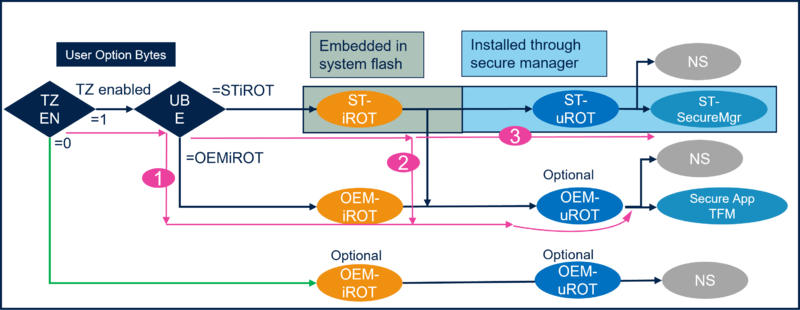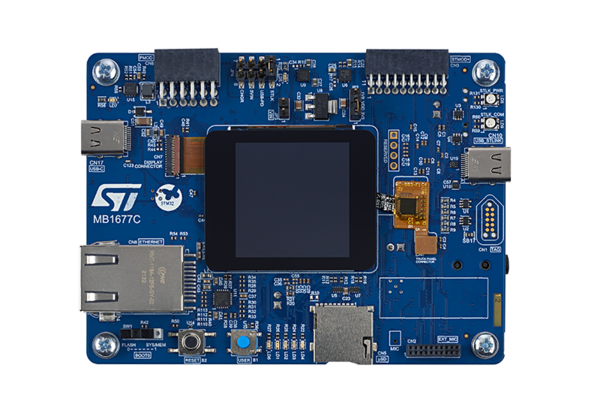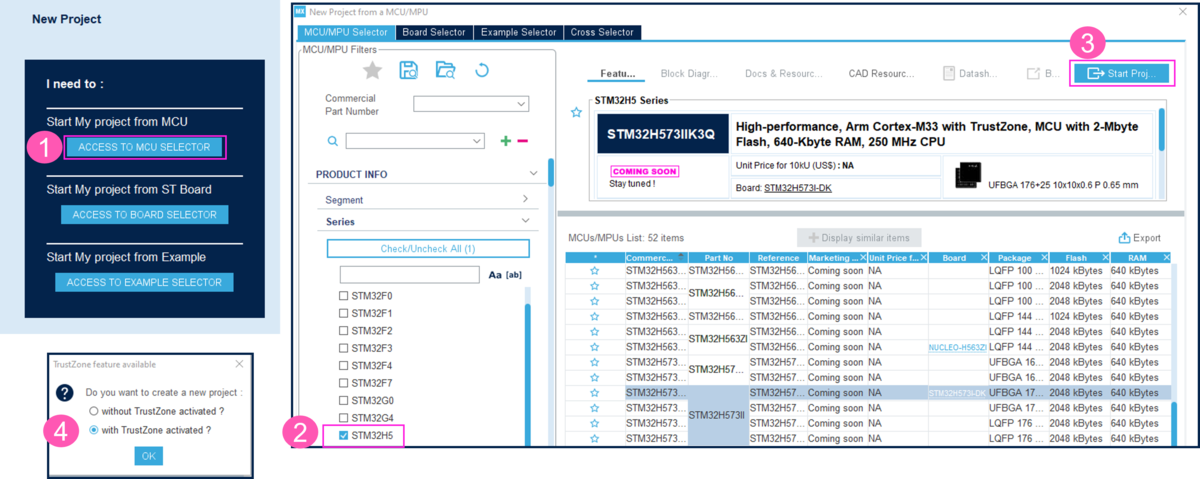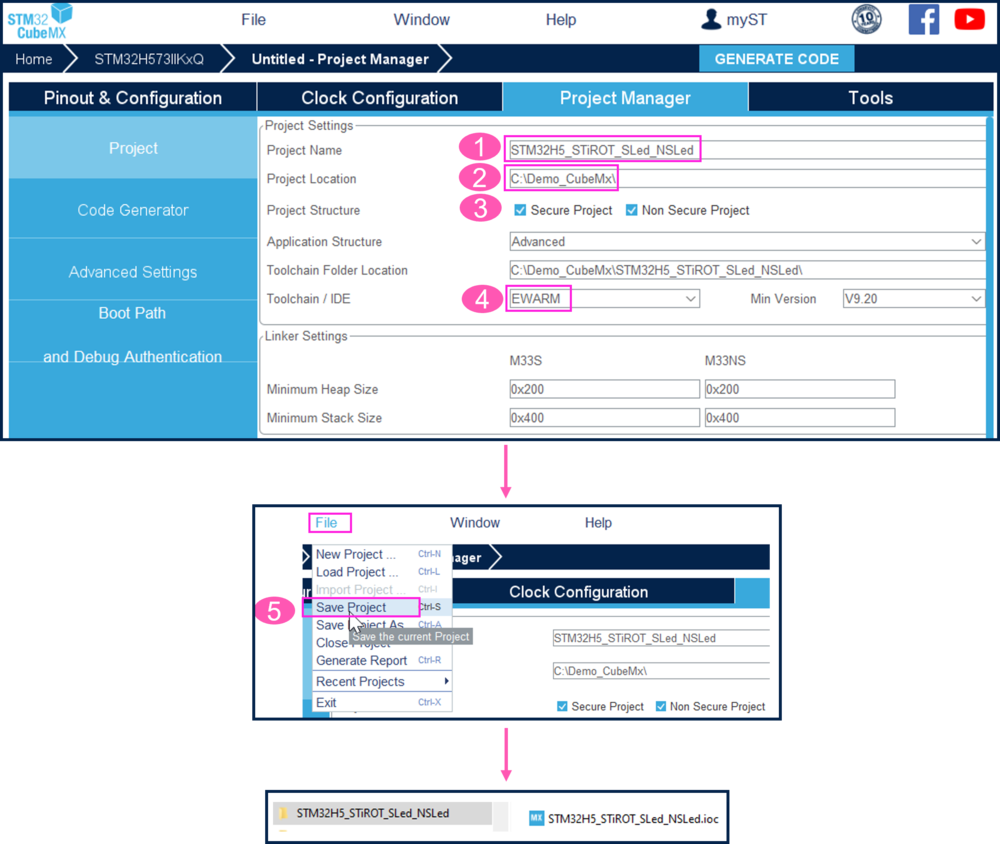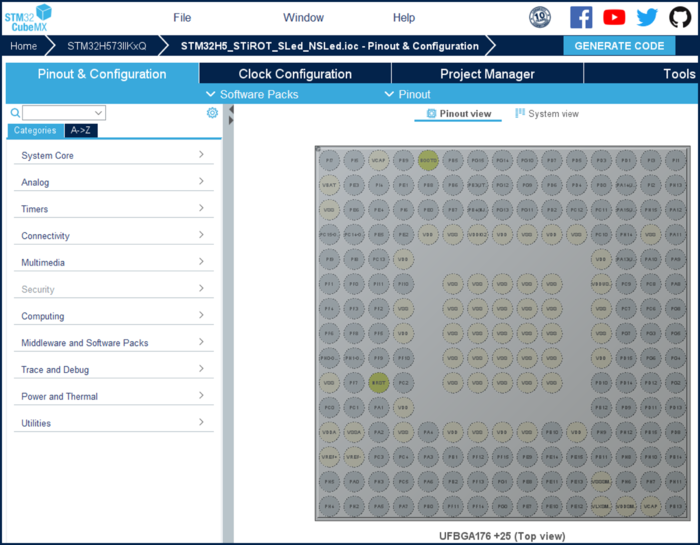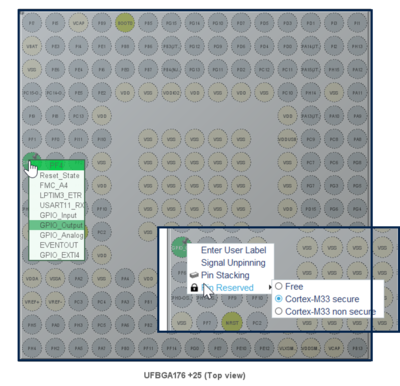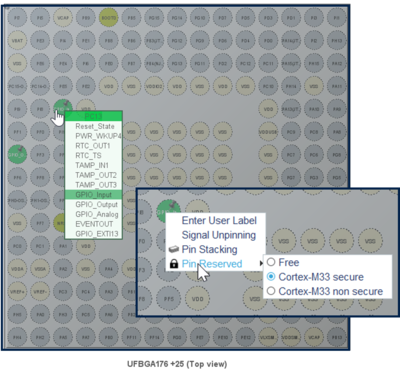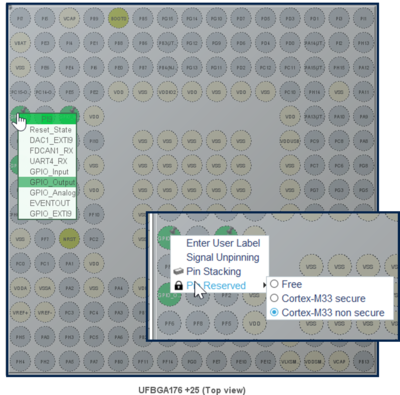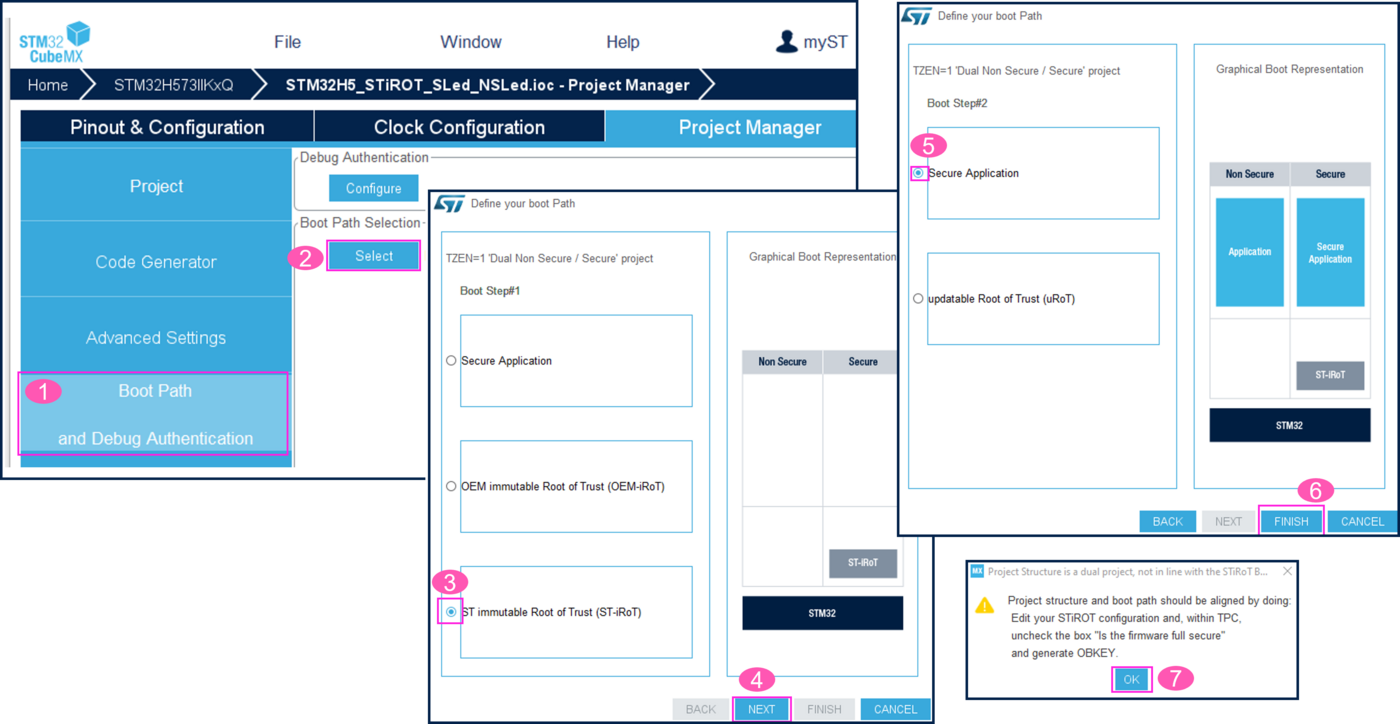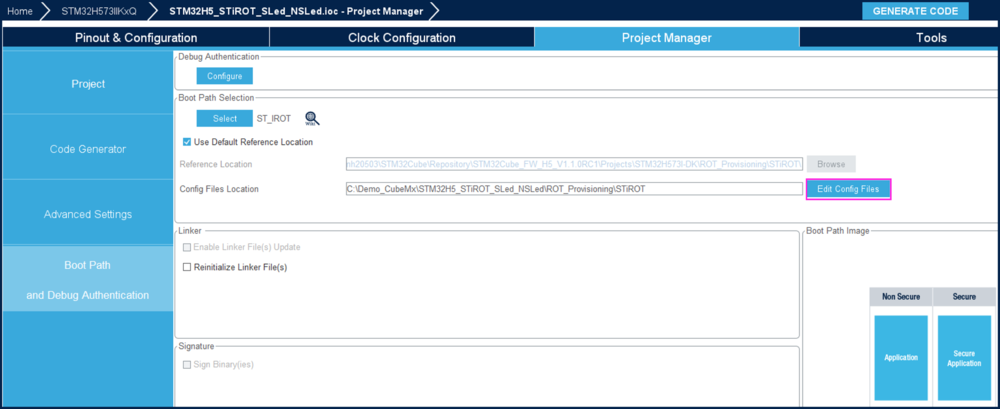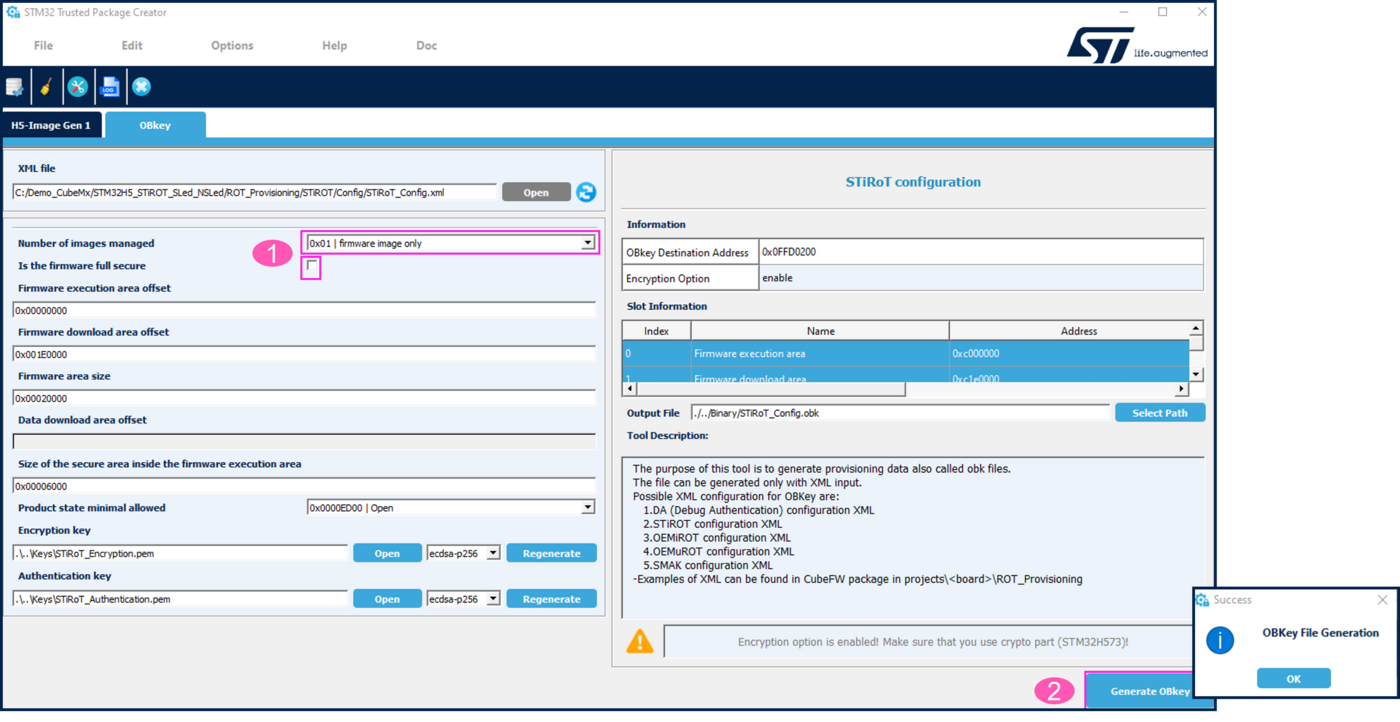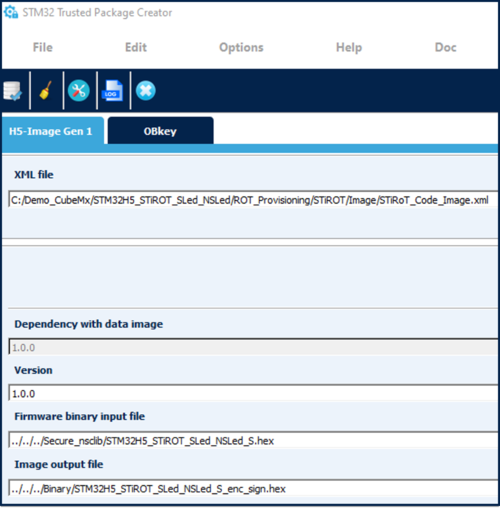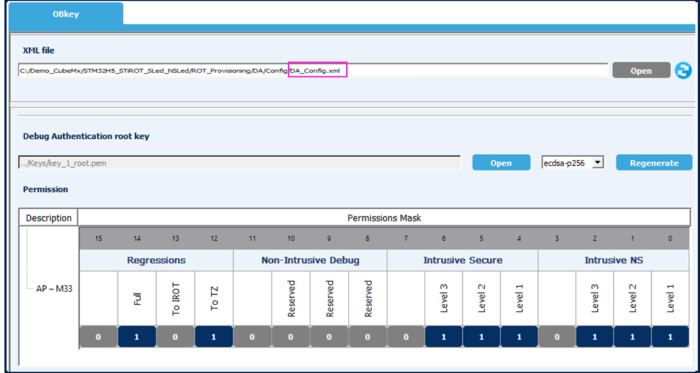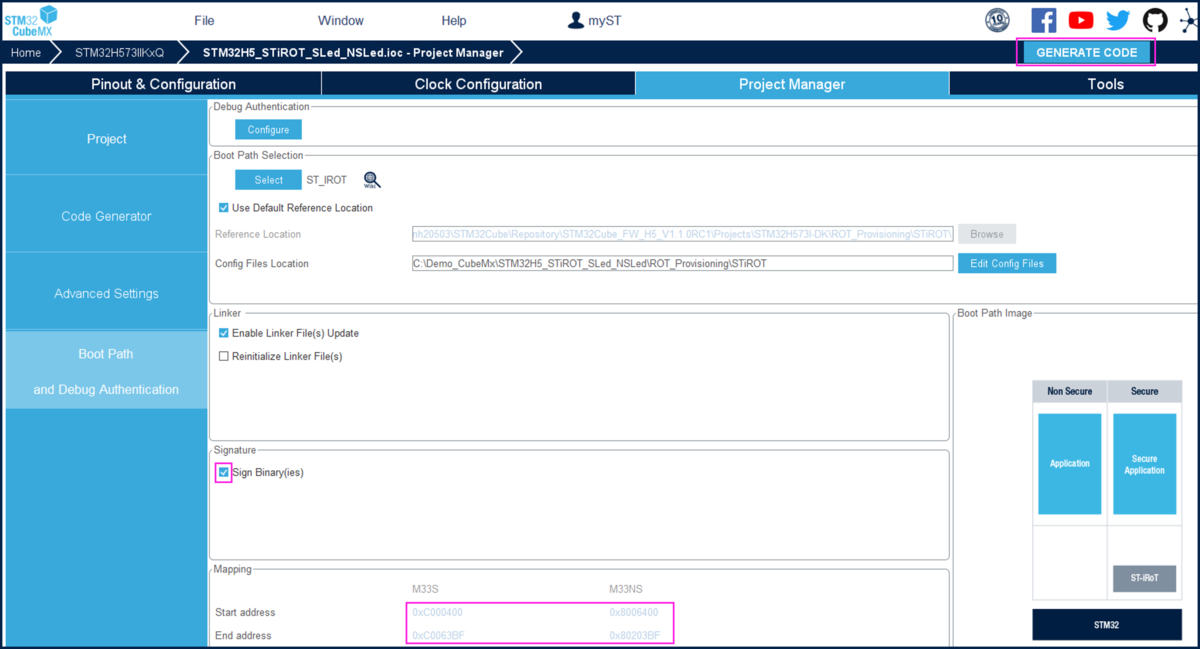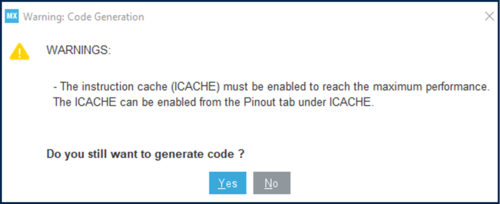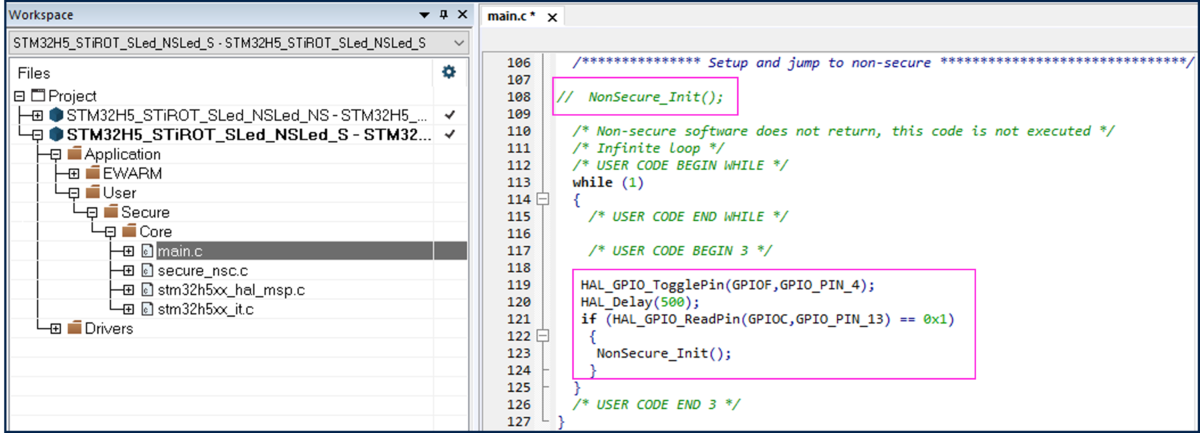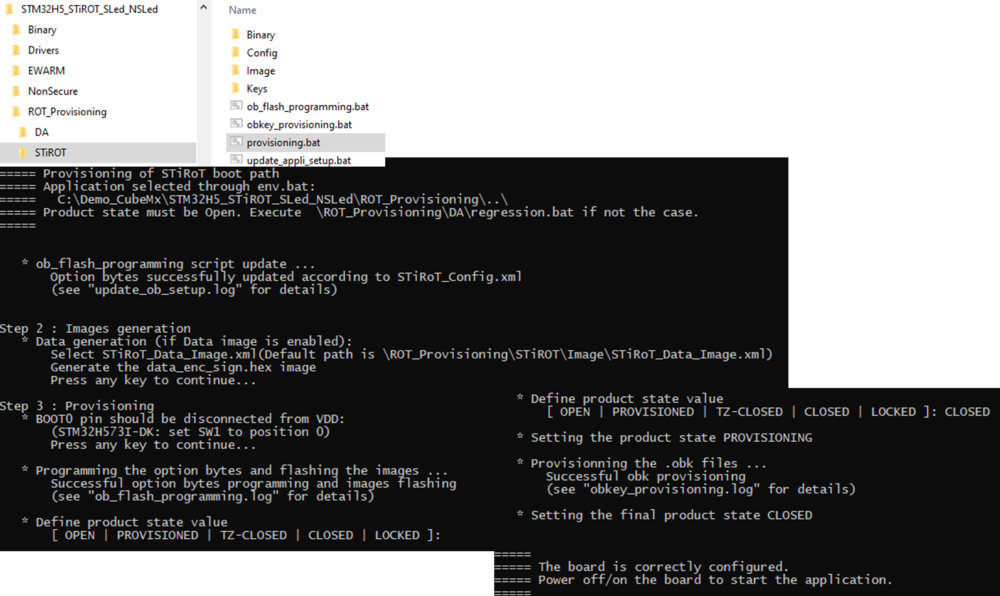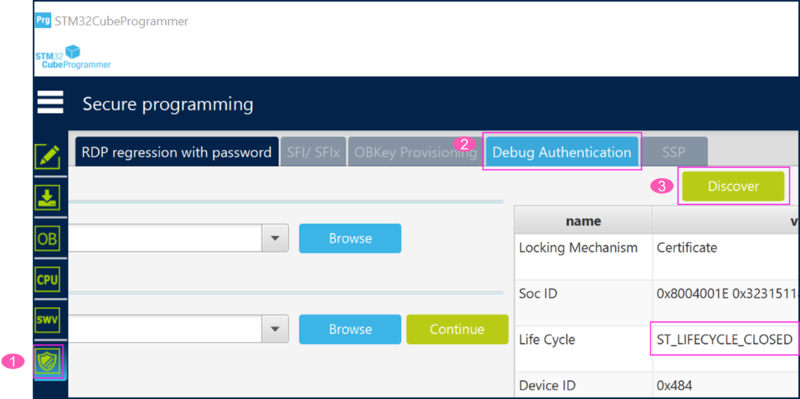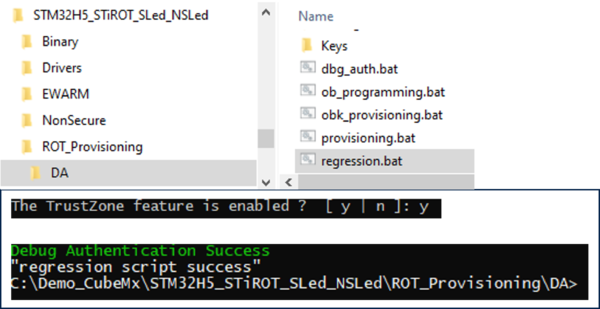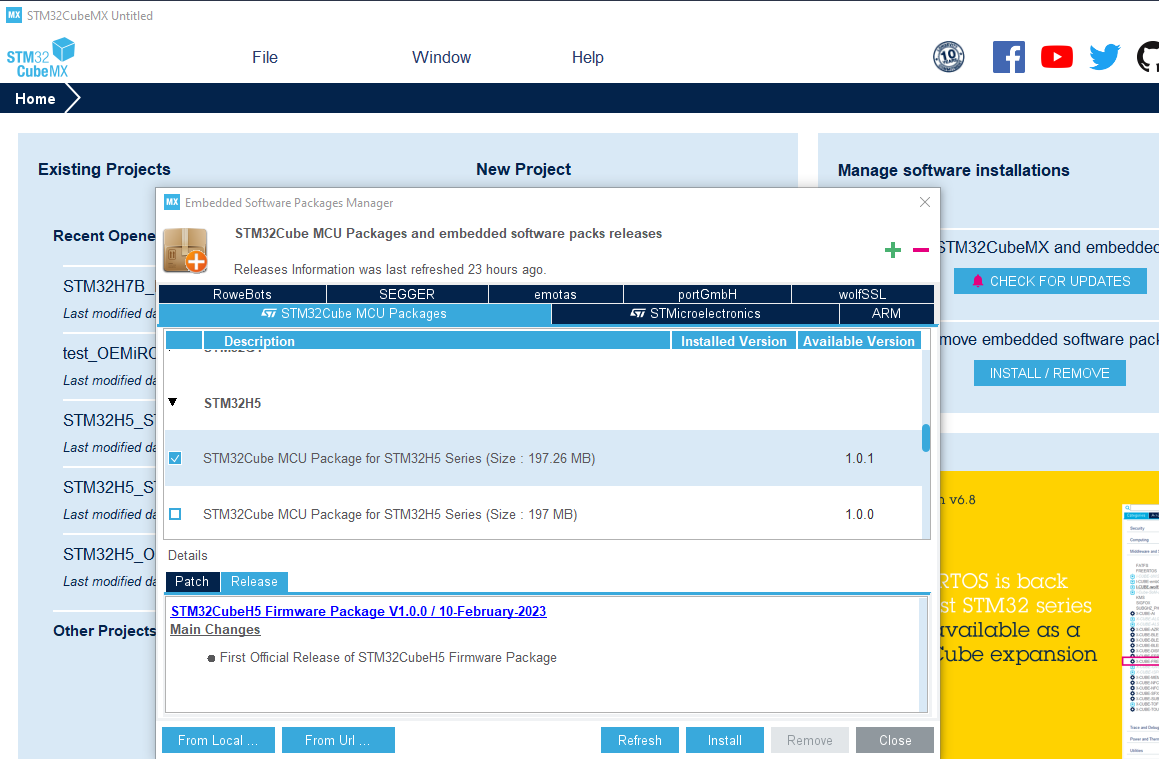| Coming soon |
Target description
The purpose of this article is to explain how to proceed step by step to generate a boot path using STM32CubeMx.
The example below demonstrates how to configure and provision a boot path for an STiROT (ST immutable Root of Trust) with a secure and nonsecure user application initial code generation.
This initial code is modified to use two LEDs and the user button present on the discovery board.
The obtained user application is:
- In the secure user application, the blue LED blinks
- Use the user button to jump to the nonsecure user application
- In the nonsecure user application, the green LED blinks.
Read the Secure Boot STM32H5 How to Introduction article before starting the practical example described below.
For more technical details which may be useful for this getting started, check out the following articles:
- Introduction article: Introduction to Secure boot and Secure firmware update.
- Specific STM32H5 bootpaths article: Secure Boot for STM32H5
- STiROT article STiROT for STM32H5
The example described in this article uses Boot path number 2, as shown in the figure below.
Note: This boot path includes STiROT (one boot stage, no OEMuROT), a secure user application, and a nonsecure user application.
Prerequisites
To execute the example described below, you'll need an STM32H573I-DK discovery board:
And the following tools:
- STM32CubeMx_6.9.0 or later (see STM32CubeMX ST web page)
- IAR Embedded Workbench rev 9.20.1 or later
- STM32CubeProgrammer rev 2.13.0
Note:
- STM32 Trusted Package Creator (TPC) is automatically installed during the STM32CubeMX installation. This TPC version is dedicated to STM32CubeMX and installed in the STM32CubeMX/utilities folder.
- The latest STM32Cube_FW revision is installed through STM32CubeMX (see appendix).
- If needed, set the windows environment variable (see appendix). It is required in case the H5 doesn’t appear in the STM32CubeMx “Access to MCU Selector”.
1. Setting up the STM32CubeMX project
Launch STM32CubeMX
- 1) Click on "Access to MCU Selector" (for this example, it's easier to enable only the needed GPIOs, so it's advised to use the MCU selector instead of the board selector).
- 2) From the "Series" column, select STM32H5, and select the device used in STM32H5-DK
- 3) Click start project
- 4) Enable TrustZone, as shown in Figure 3. (For the STiROT bootpath, TrustZone needs to be enabled).
Create STM32CubeMX project:
- 1) Type the name of the project (if it doesn't already exist, the related folder will be created).
- 2) Choose a folder for the project (avoid long path).
- 3) Check that both Secure Project and Nonsecure Project checkboxes are ticked (they should be checked by default).
- 4) Select the relevant Toolchain; for this example EWARM is used.
- 5) Go to File > Save Project. The project folder (if it doesn't already exist) and the STM32H5_STiROT_SLed_NSLed.ioc file will be created.
2. GPIO configuration
For this example, three GPIOs need to be configured for the discovery board:
- PF4 for the blue LED, used in the secure user application code
- PC13 for the blue user button used in the secure user application code
- PI9 for the green LED, used in the nonsecure user application code
In STM32CubeMX, select the Pinout & Configuration window:
To configure the GPIO for the blue LED:
- Click on PF4 and select GPIO_Output -> a push pull output will be configured need to drive an LED
- Click right on PF4 and select Cortex-M33 secure. This assigns the GPIO to the secure user application code
To configure the blue user button:
- Click left on PC13 and select GPIO_Input
- Click right on PC13 and select Cortex-M33 secure. This assigns the GPIO to the secure user application code.
To configure the GPIO for the green LED proceed as follow:
- Click left on PI9: select GPIO_Output -> a push pull output will be configured need to drive an LED
- Click right on PI9: and select Cortex-M33 non-secure. This GPIO is then assigned to the non-secure user application code
- Select System Core -> select GPIO: the summary of the settings are displayed as shown in the figure below
3. Configure the STiROT bootpath
To configure the bootpath number 2 of the figure 1 proceed as follow:
- 1) Click on "Boot Path and Debug Authentication"
- 2) Click on "Select"
- 3) Select the STiROT. The TZ activation has already been chosen (figure 3), this selection is defining the UBE option byte (figure1) (but you don't need to take care about the setting of this option byte).
- 4) Click on "Next"
- 5) Select Secure Application (since for this example there is no OEMuROT, so no second boot stage)
- 6) Click Finish
Note: depending on the STM32CubeMx version, the Debug Authentication Configure button can't be selected before completing the STiROT boot path configuration.
Probably you have the message indicated in the figure above.
The default configuration file is set for a full secure user application, the next two figures show how to proceed.
In the Project Manager window, select Edit Config, as shown in the figure below.
It will automatically open STM32Trusted Package Creator (TPC).
And the following window is displayed.
- 1) Deselect "Is the firmware full secure" in case it was not the case, (the rest of the configuration is valid for this example)
- 2) Generate the OBKey file
Notes:
- The figure above, shows the path where the STiROT_Config.xml file is located. This file contains the complete setting for the STiROT.
- A default firmware execution area and download area are defined. During the provisioning the download area is used to store the encrypted user application, that is decrypted by the STiROT and installed in the execution area (refer to the STiROT_for_STM32H5 article).
- The firmware area size is the total size of the secure and non secure user application codes (the secure area size is indicated separately)
- The generated STiROT_Config.obk is used during the provisioning to configure the STiROT in the device.
As mentioned above, for this example you don't need to make any other updates of the default configuration.
But if you make your own code that don't fit in these defined sizes, you will need to redo the configuration and regenerate the OBKey when the final code size is defined.
To protect your code, you need to regenerate the encryption and authentication keys.
Select H5-Image Gen1 as shown in figure below
No modification to be done in this window, just some explanations:
- The STiROT_Code_Image.xml file contains the settings needed to generate the images.
- Two paths are indicated for binary files:
- During the code compilation using the IDE, a binary file containing the compiled secure and non-secure user application is created.
- The IDE will also perform a postbuild command to generate from this binary input files a single encrypted and signed binary image.
- Note: The above mentioned paths are updated by STM32CubeMx and must not be modified.
- Close STM32 Trusted Package Creator
4. Debug Authentication
Refer to the Debug_Authentication_for_STM32H5_MCUs article for more details.
A default configuration file (fully functional) and related OBKey file are provided through the STM32CubeFW.
To customize the Debug Authentication proceed as following:
- In STM32CubeMx -> Project Manager -> Select: Boot Path and Debug Authentication -> select: Configure.
- The STM32Trusted Package Creator is launched (TPC installed together with STM32CubeProgrammer) and the DA_Config.xml file is automatically open.
- The "key_1_root" key is needed to reopen the device or to perform a regression. To protect you own developed application, this key needs to be regenerated. If regenerated, it's important to not lose this new key.
- Don't regenerate the key for this example
- The permission mask is set to allow all possible regressions and debug openings in the secure and non-secure user application. See Debug_Authentication_STM32H5_How_to_Introduction article for more details.
This permission mask, called the SOC mask is stored in the device during the provisioning process.
The owner of the root key has then the defined privileges to perform a regression or open the debugger according set permissions.
- Generate the OBKey file that will be used during the provisioning, click:
- Close STM32Trusted Package Creator
5. Initial Code Generation and modication
Select Project Manager in STM32CubeMX
- Ensure Sign Binaries is selected -> at each user application code compilation using the IDE an encrypted and signed binary is created containing both secure and non secure user application (compilation -> postbuild command)
- Note that start and end address are indicated for the secure and non-secure according to the STiROT configuration
- Click Generate Code.
- You can have the following warning message. Click yes to generate the code.
- Or if you want to enable the Instruction Cache, select the Pinout Tab (see figure 9, select ICache located just below the GPIO configuration)
- Open generated user application.
Open the secure user application code
- Comment out NonSecure_Init() for the jump into the non secure user application code (replaced with the code below).
- Insert the following code as shown in the figure below
HAL_GPIO_TogglePin(GPIOF,GPIO_PIN_4);
HAL_Delay(500);
if (HAL_GPIO_ReadPin(GPIOC,GPIO_PIN_13) == 0x1)
{
NonSecure_Init();
}
This code will make the blue LED blinking with the chosen Delay, showing that the secure user application is executed.
If the user blue button is pushed the jump in the non secure code is done through the Non-Secure_Init .
- Compile the code using the IDE (Project -> Rebuild all).
- Note: the secure code need to be compiled first (before the non-secure code)
Open the non-secure user application
- Insert the following code as shown in the figure below
HAL_GPIO_TogglePin(GPIOI,GPIO_PIN_9);
HAL_Delay(800);
This code will make the geen LED blinking with the chosen Delay, showing that the non-secure user application is executed.
- Compile the code using the IDE (Project -> Rebuild all).
For this STiROT use case, two binaries are created as shown in the figure below.
- The assembled binary of the secure and non-secure user application
- The binary obtained after encryption and signature of the assembled binary. The signed and encrypted file is generated through the automatically called postbuild command (ticked "Sign Binary" in the window figure 16).
6. Device Provisioning
For the device provisioning the OBKey files generated previously are used to configure the device STiROT accordingly and to configure the Debug Authentication according to the permission mask.
The encrypted and signed binary is uploaded in the download area defined during the STiROT configuration.
The STiROT verifies the authenticity, decrypt and install the secure and non-secure user applications in the execution area defined during the STiROT configuration.
For the provisioning STM32CubeProgrammer Command Line (CLI) are called automatically by the provisioning script.
It's important that the path to the STM32CubeProgrammer is correct in the env.bat file. Check and update as shown in the figure below:
! Don't modify the path to the STM32TrustedPackageCreator included in the STM32CubeMX.
The provisioning of the device is done using the provided provisioning script.
- Connect your board with the USB cable (USB STLink connector)
- Double click on the provisioning.bat shown in the figure below
- The provisioning Step 1 is the configuration
- The STiROT configuration setting done previously (generation of the related STiRoT_Config.obk file)
- The DA configuration setting done previously (generation of the related DA_Config.obk file)
- As first step the script will update the option bytes accordingly
- The provisioning Step 2 is the image generation
- The user application code image generation has been done previously during the compilation and the postbuild.
- The image generation is not applicable for this example -> type any key
- The provisioning Step 3 is the board provisioning
- Before typing any key, check the indicated boot switch position
- The STM32H5 device provisioning is executed, the configuration is stored, and the user application codes are installed
- The last Step is the product state setting, for this example the device is set in CLOSED
- After the message that the board is correctly configured, the script can be closed.
See Security:Introduction_to_Silicon_device_life_cycle and Security:Debug_Authentication articles for detail explanations.
7. Code execution
- Press the black reset button, the blue LED is blinking showing that the secure user application is executed
- Press the blue button, the green LED is blinking showing that the jump to the non-secure application has been successful and that the non-secure code is executed.
8. STM32CubeProgrammer, discovery command
- Start STM32CubeProgrammer and try to connect.
- The error message below is displayed because the device has been set in CLOSED state and the debugger can't be connected even to see the non-secure user application code.
- To reopen the debugger a Debug Authentication is needed and the opening can only be done by the owner of the root key.
The product state can be seen using the Discovery command (see figure below):
- 1) In STM32CubeProgrammer click on the shield icon
- 2) Select Debug Authentication
- 3) Click on Discover, the lifecycle CLOSED is displayed.
An example on how to reopen the debugger, view the code and attach an IDE to perform a step by step application execution is shown in the chapter 6.1 of the article :How_to_start_with_ST-iROT_on_STM32H573
9. Regression
The regression will remove the user applications and protections.
After completing a handson, if your board is not in OPEN state, it's advised to perform a regression mainly if you have regenerated the root key.
- Double click to start the regression script shown in the figure below
- The regression is performed automatically. The Debug Authentication is done using the root and using the permission defined during the STiROT configuration
- You can connect STM32CubeProgrammer and see that the debugger is again open and that the flash is fully erased.
10. Appendix
10.1. STM32CubeMX installation
To install STM32CubeMX, refer to the following link: STM32CubeMX ST web page
10.2. STM32CubeFW installation
The STM32CubeFW needs to be installed through STM32CubeMX.
- Step 1: the repository folder has to be defined:
- In STM32CubeMx: Help menu -> Updater Settings
- Browse the repository you have chosen for the STM32CubeFW
- Step 2: STM32CubeFW installation
- In STM32CubeMX: Select Install/Remove
- In the description frame: select STM32H5
- Select the CubeFW package to install
- In case you have locally the zip file of the STM32CubeFWH5: it can be installed by drag and drop this file in the description window
Note: only official STM32CubeFW release can be installed by STM32CubeMX.
